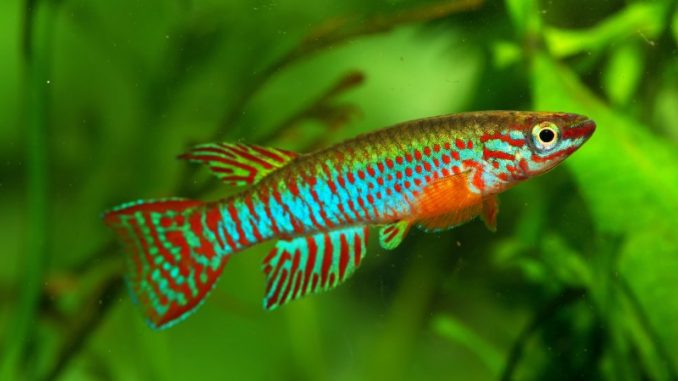
Killifish are small and colorful egg-laying fish of the Cyprinodontiformes order. There are over 1,200 species of killifish that belong to different families.
Killifish are found in freshwaters of the Americas and are made popular among aquarists by their beautiful colors. Most species are easy to care for, get along well with other tropical fish, and are easy to find in most US pet stores.
TABLE OF CONTENTS
Clown Killifish
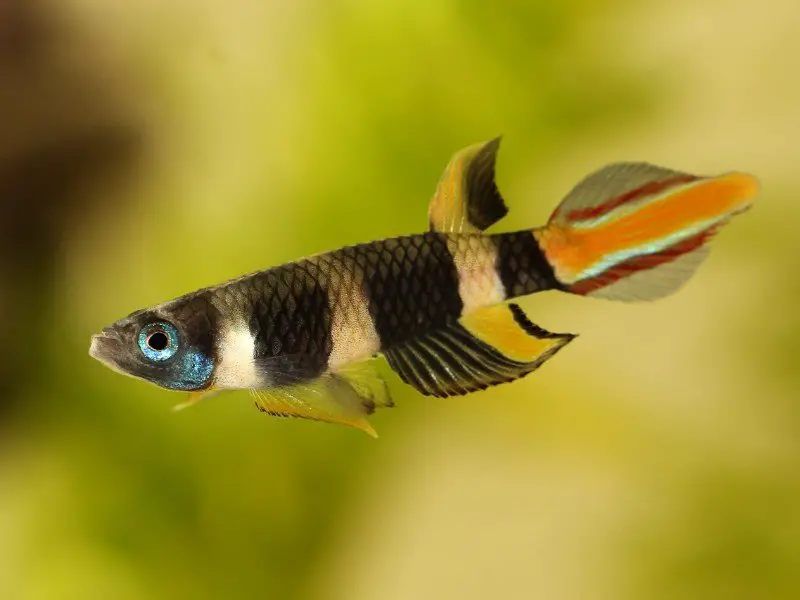
| Care level: | Temperament: | Color: | Lifespan: | Size: |
| Moderate | Peaceful | Varied bright colors with black stripes | 5 years | 1.2–1.4 inches |
| Water temperature: | Water pH: | Tank size: | Diet: | Scientific name: |
| 69–78°F | 4.0–7.0 | 5–10 gallons | Carnivore | Epiplatys annulatus |
Clown killifish are popular among aquarists for their black-striped, small, elongated bodies and colorful, red-and-blue tails.
This species of killifish is easy to care for thanks to its peaceful temperament, flexible diet, and ability to thrive in a small tank.
Set up a clown killifish tank environment to mimic the fish’s wild West African swamp habitat. Decorate the tank with rocks for the fish to hide behind and plants to cleanse the water. Feed the clown killifish a varied diet of protein-rich foods including insects, brine shrimp, and small worms.
Clown killifish get along well with other killifish and other peaceful species that stay out of the clown killifish’s way. Since clown killifish tend to spend most of their time at the surface of the water, pair them with bottom-feeders or small fish that tend to spend most of their time near the bottom of the tank.
In a 5-gallon tank, keep up to four pairs of killifish.
Red-Striped Killifish
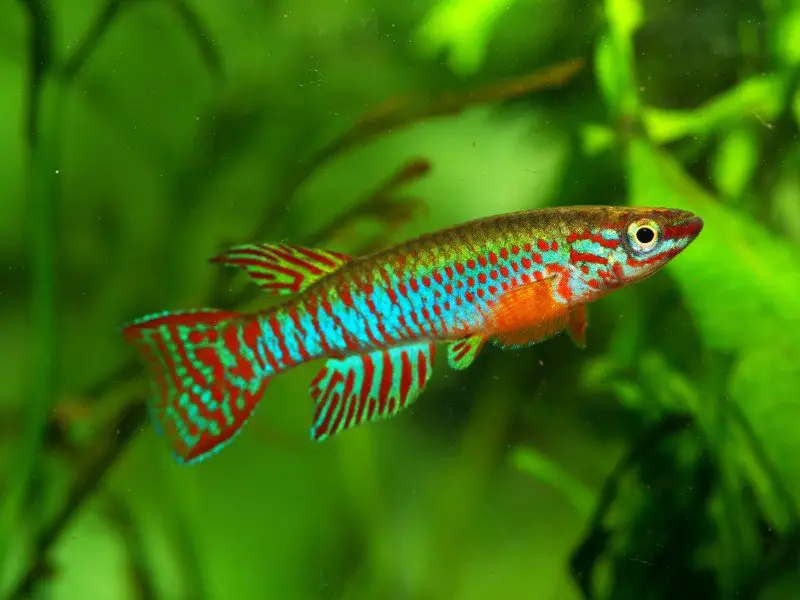
| Care level: | Temperament: | Color: | Lifespan: | Size: |
| Easy | Peaceful | Red, orange, blue | 3–5 years | 2 inches |
| Water temperature: | Water pH: | Tank size: | Diet: | Scientific name: |
| 68–73°F | 6.5–7.5 | 10 gallons | Carnivore | Aphyosemion striatum |
The red-striped killifish is a popular fish for beginner aquarists because of its peaceful temper and neon colors. This small fish has a slender body with red dots and irregular horizontal stripes over a blue and orange background.
In the wild, red-striped killifish inhabit freshwater swamps and slow-moving, shallow rainforest rivers. Red-striped killifish prefer tank conditions similar to those of their natural habitat.
Control for slightly acidic, soft water, locate the tank where it receives minimal lighting and plant the aquarium with rich vegetation.
Choose a tank with a firm lid since red-striped killifish jump very high and can end up on the floor. In the tank, the red-striped killifish can coexist with other peaceful small fish. More aggressive and territorial species will likely cause shy red-striped killifish to become stressed.
Red-striped killifish feed on a combination of high-quality flakes and frozen foods.
Magnificus Killifish
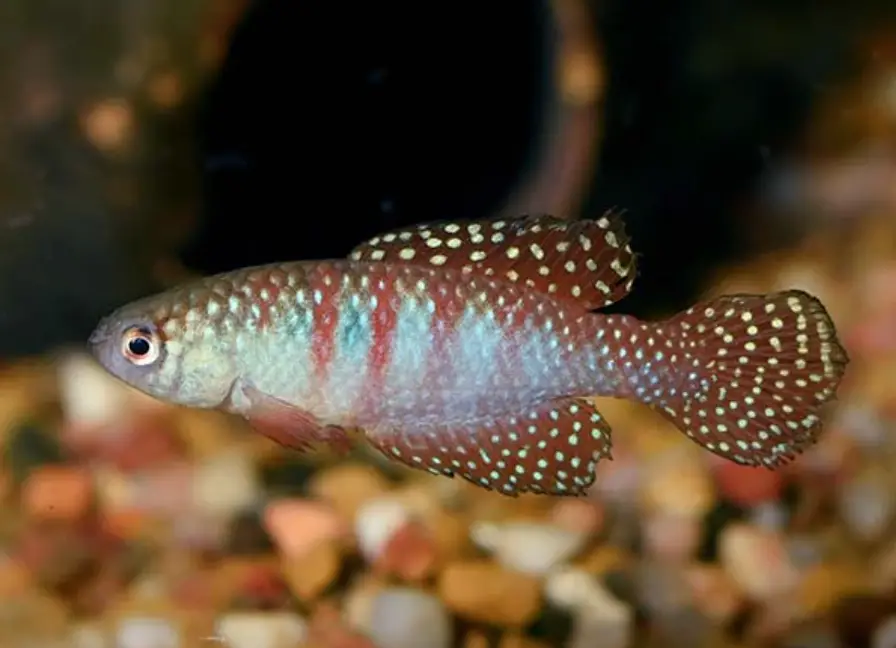
| Care level: | Temperament: | Color: | Lifespan: | Size: |
| Easy | Peaceful | Varied bright colors | 2 years | 1 inch |
| Water temperature: | Water pH: | Tank size: | Diet: | Scientific name: |
| 72–75°F | 5.0–7.2 | 5–10 gallons | Carnivore | Hypsolebias magnificus |
The magnificus killifish is a peaceful fish that gets along well with tropical fish of similar size and temperament.
The magnificus is one of the smaller types of killifish, and has beautiful rainbow coloration. This fish is light blue with multi-colored stripes across its body and a display of iridescent dots on its tail and fins.
This killifish is native to slow-running, freshwater streams in South America. Replicate the magnificus killifish’s natural environment by providing a low-power tank filter that allows the fish to swim freely and does not restrict their movement.
Maintain soft, clear tank water with slightly higher temperatures compared to that of other killifish species. Decorate the magnificus killifish’s tank with floating plants.
Like most killifish, magnificus killifish accept most live foods including brine shrimp, worms, and small insects.
Chocolate Lyretail

| Care level: | Temperament: | Color: | Lifespan: | Size: |
| Easy | Peaceful | Orange, red | 2 years | 2–3 inches |
| Water temperature: | Water pH: | Tank size: | Diet: | Scientific name: |
| 70–75°F | 6.0–6.5 | 10 gallons | Carnivore | Aphyosemion australe |
The chocolate lyretail is a popular killifish for beginner aquarists and is loved for its bright orange colors and adaptable character. Its orange and light brown coloring with bright red dots adds lively colors to the fish tank.
Males have brighter coloration than females, as well as a recognizable lyre-shaped tail and spiked fins.
Chocolate lyretails are native to West Africa, where their natural habitats are small river streams and ponds in the jungle.
Though chocolate lyretails can adapt to various water conditions, they prefer warm water in the tank that is soft and slightly acidic. Like most killifish, lyretails enjoy vegetation, such as floating plants, in their tank.
Chocolate lyretails are friendly fish that coexist with many other species, but they require space to swim around freely. While chocolate lyretails can be kept in a tank as small as 5 gallons, they enjoy a 10- or 15-gallon tank more.
These fish get stressed in a crowded tank, so remember to limit the number of fish in a community tank. High levels of stress can cause loss of color and low levels of activity.
These killifish are carnivores and will feed on frozen high-protein foods and good-quality flakes.
Blue Lyretail

| Care level: | Temperament: | Color: | Lifespan: | Size: |
| Moderate | Semi-aggressive | Yellow, red, blue | 3 years | 2.5 inches |
| Water temperature: | Water pH: | Tank size: | Diet: | Scientific name: |
| 68–79°F | 6.0–7.5 | 10 gallons | Omnivore | Fundulopanchax gardneri |
The blue lyretail is a beautiful species of killifish that displays vivid yellow and red colors.
The male blue lyretail is brighter than the female and has a distinct lyre-shaped, yellow tail with characteristic bright red dots. The blue lyretail killifish has a large mouth that makes this species recognizably dangerous to other fish.
Blue lyretails inhabit swamps and lakes in African countries including Cameroon and Nigeria. The fish feel comfortable in warm, soft waters and are highly adaptable to various freshwater tank conditions.
This fish fits into a lively community tank but can show signs of aggression in a tank with too many males of its own kind. Keep one or two male blue lyretails for 4-5 females of the same kind.
The blue lyretail is an omnivore and enjoys a diverse diet of flakes, pellets, algae, and live foods.
Two Stripe Lyretail
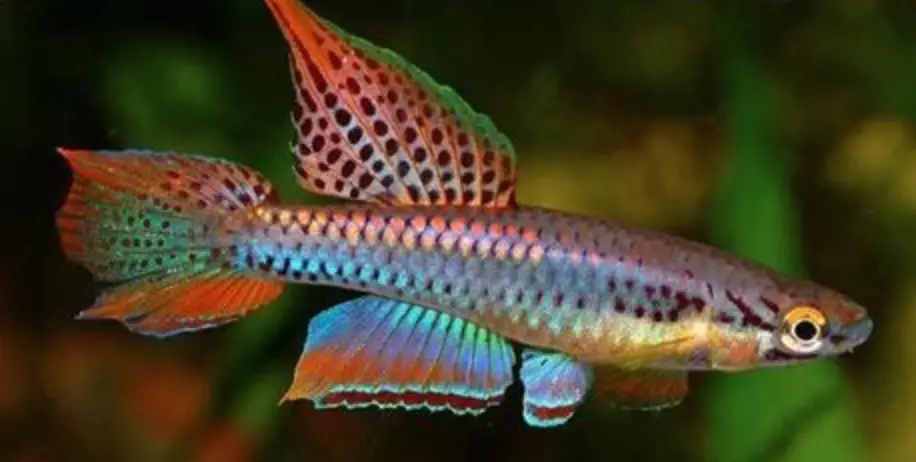
| Care level: | Temperament: | Color: | Lifespan: | Size: |
| Easy | Peaceful | Varied bright colors | 3–5 years | 2 inches |
| Water temperature: | Water pH: | Tank size: | Diet: | Scientific name: |
| 70–79°F | 5.5–7.0 | 10 gallons | Carnivore | Aphyosemion bivittatum |
Two stripe lyretails are great beginner fish for novice aquarists. These brightly colored fish have elongated bodies with two dark red stripes running along each side. Males have distinct, colorful anal and dorsal fins that display a variation of blue, green, and orange colors.
This small killifish species is native to rivers in Nigeria and Cameroon. Replicate its wild habitat by providing a variety of green floating plants and bogwood in the tank. Two stripe lyretails prefer warm, soft water with slight acidity.
Two stripe lyretails are carnivores. They thrive on a varied diet that includes brine shrimp, mosquito larvae, bloodworms, and flakes. Two stripe lyretails feed in the upper levels of the aquarium.
Avoid placing two stripe lyretails with other fish that live at the surface, to avoid competition for food in the top levels of the tank.
Argentine Pearlfish
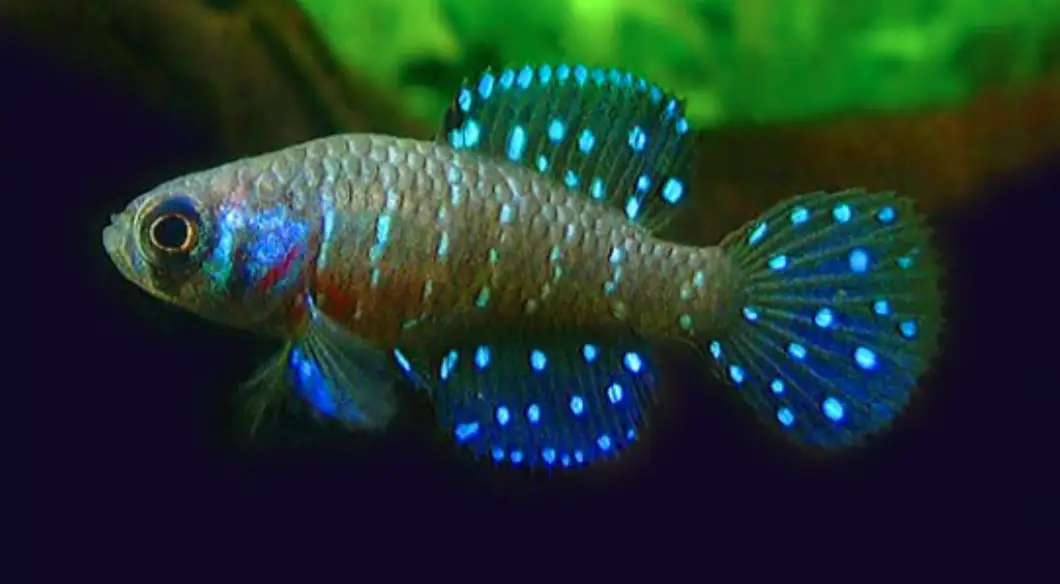
| Care level: | Temperament: | Color: | Lifespan: | Size: |
| Moderate | Semi-aggressive | Black, blue, white | 8 months | 2.75 inches |
| Water temperature: | Water pH: | Tank size: | Diet: | Scientific name: |
| 65–72°F | 6.5–7.0 | 15 gallons | Carnivore | Austrolebias bellottii |
The Argentine pearlfish is a less-colorful killifish than other killifish species. It is recognized by its sprinkling of pear-shaped white dots across its dark-blue or black body.
The Argentine pearlfish is native to the rivers of Uruguay and Argentina. It prefers cold water temperatures and enjoys soft, slightly acidic water.
Like most killifish, the Argentine pearlfish prefers a dimly-lit tank with lots of plants to mimic the conditions of its natural habitat. This killifish species requires frequent water changes to stay healthy.
Argentine pearlfish can be aggressive to fish of their own kind, as well as to other tropical fish in the tank. The best way to avoid aggression between Argentine pearlfish is to keep a ratio of one Argentine pearlfish male to four to five females of its own kind in one tank.
Feed Argentine pearlfish a variety of protein-rich foods including fish flakes, small insects, and brine shrimp.
Kisaki Killifish
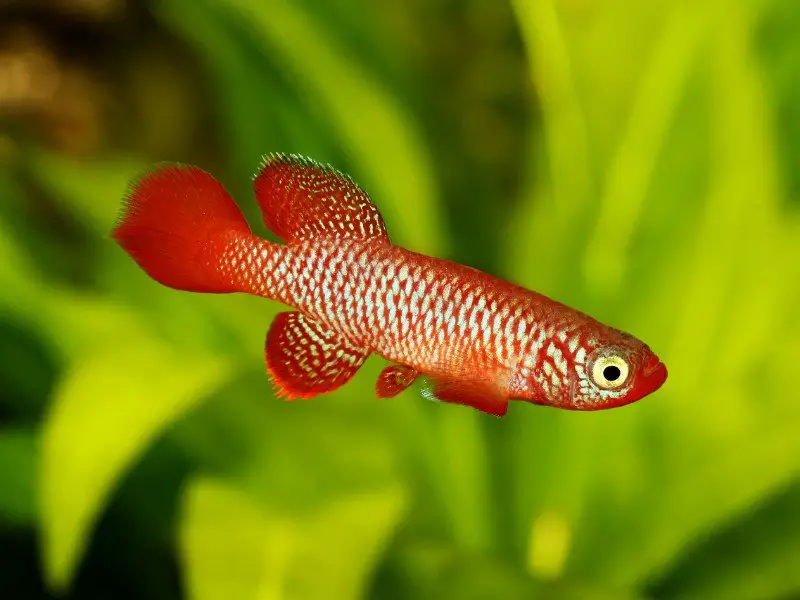
| Care level: | Temperament: | Color: | Lifespan: | Size: |
| Easy | Peaceful | Red, orange | 1–2 years | 2.5 inches |
| Water temperature: | Water pH: | Tank size: | Diet: | Scientific name: |
| 70–80°F | 6.5–7.0 | 10 gallons | Carnivore | Nothobranchius flammicomantis |
The Kisaki killifish is a beautiful bright red killifish with spectacular blue eyes, loved for the color it adds to the tank.
This fish is native to Tanzania where it inhabits ponds and slow streams. The Kisaki killifish prefers warm water temperatures in the tank with neutral pH, and a muddy substrate at the bottom of the tank to replicate the conditions of its natural habitat.
Although the Kisaki killifish is peaceful, keeping one male with several females in a small tank is best. If you want more than one male, keep Kisaki killifish in a larger tank of at least 20 gallons so that the males have enough space and don’t fight for territory.
Kisaki killifish thrive on a high-protein meaty diet of brine shrimp, worms, insects, pellets, and flakes.
American Flagfish

| Care level: | Temperament: | Color: | Lifespan: | Size: |
| Moderate | Semi-aggressive | Varied bright colors | 1–2 years | 2.6 inches |
| Water temperature: | Water pH: | Tank size: | Diet: | Scientific name: |
| 59–70°F | 7.0–8.0 | 15 gallons | Omnivore | Jordanella floridae |
The American flagfish is a popular species of killifish admired by aquarists for its striking appearance and high adaptability to various tank conditions.
The name of the American flagfish was inspired by the fish’s red and blue markings. Both male and female American flagfish have a characteristic black spot on their side.
American flagfish come from Florida and the Central American states. They inhabit slow-running streams, ponds, and swamps in their natural habitat. American flagfish enjoy spacious tanks with a variety of hardy plants and multiple hiding spots.
This species of killifish is mostly peaceful and can coexist with other species of similar sizes and temperaments. However, the fish does become aggressive and territorial during the breeding period.
While American flagfish will accept a variety of high-quality flakes and pellets, include some live protein foods like bloodworms in the fish’s diet. Because this species is omnivorous, keep in mind that the fish might nibble on soft delicate plants in the tank as an herbal addition to their meal.
Blue Gularis

| Care level: | Temperament: | Color: | Lifespan: | Size: |
| Moderate | Semi-aggressive | Varied bright colors | 5 years | 3.5–5 inches |
| Water temperature: | Water pH: | Tank size: | Diet: | Scientific name: |
| 73–79°F | 6.0–7.0 | 20 gallons | Carnivore | Fundulopanchax sjoestedti |
The blue gularis is a large species of killifish enjoyed by experienced aquarists for the beautiful colors and gracious movements it adds to the tank. A male blue gularis has distinct multi-colored patterns on its body and delicate blue and green fins.
The blue gularis originates from tropical African climates, including countries like Nigeria and Cameroon, where it inhabits swamps and ponds in coastal rainforests. This fish enjoys a large tank with dark substrate, and a variety of plants to provide shelter from the light.
Blue gularis killifish are not recommended for beginner aquarists because the fish have semi-aggressive temperaments and high tank hygiene standards.
They adapt well to living in a tank with other tropical fish. However, house blue gularis killifish with tank mates that spend most of their time at the surface of the water, out of the blue gularis’ way. Blue gularis killifish prefer to dominate and feed in the middle to lower parts of the tank and may fight with other species that occupy this space.
Feed blue gularis killifish live foods as the major part of their diet. Live worms, insects, and small shrimp are good choices.
Redtail Notho
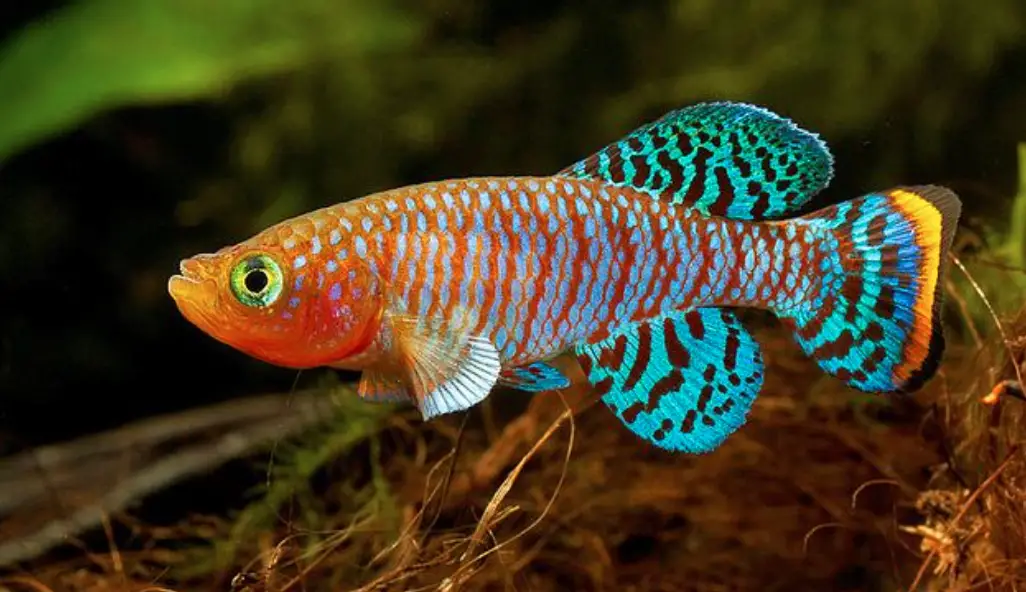
| Care level: | Temperament: | Color: | Lifespan: | Size: |
| Easy | Peaceful | Blue, red | 1–2 years | 2.5 inches |
| Water temperature: | Water pH: | Tank size: | Diet: | Scientific name: |
| 70–80°F | 6.0–6.5 | 10 gallons | Carnivore | Nothobranchius guentheri |
The redtail notho is one of the most popular types of killifish among aquarists. This species of killifish is easy to care for because of its small size, friendly characteristics, and smooth adaptability to the tank.
The redtail notho killifish gets its name from its beautiful bright-red tail and fins, and gradient-like blue- and yellow-scaled body.
Redtail nothos are native to the hotter regions of East Africa, like Tanzania and Zimbabwe, where they live in temporary pools created by seasonal rains. Redtail nothos prefer warm, clear tank water to mimic their natural habitat pools.
The redtail notho is a peaceful fish that makes a good tank mate to a community of small tropical fish. Redtail nothos can become territorial with their own kind, so limit the number of males in one tank to avoid conflict. Feed redtail nothos a varied high-protein diet consisting of live and frozen foods.
Blue Notho
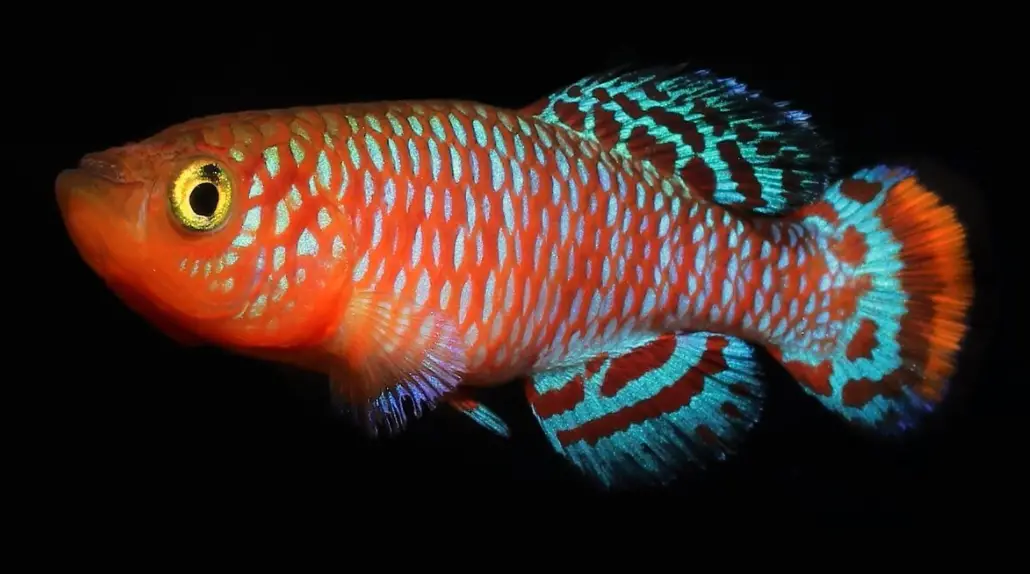
| Care level: | Temperament: | Color: | Lifespan: | Size: |
| Easy | Peaceful | Blue, orange | 1–2 years | 2.5 inches |
| Water temperature: | Water pH: | Tank size: | Diet: | Scientific name: |
| 70–80°F | 6.0–6.5 | 10 gallons | Carnivore | Nothobranchius guentheri |
The blue notho is a close relative of the redtail notho, and is another popular killifish among aquarists. The blue notho is an excellent beginner fish that adapts well to a community of fish and can handle fluctuating water temperatures. This small fish has metallic blue fins and tail, and bright orange body.
Like redtail nothos, blue nothos are native to East African pools and swamps. Blue nothos are used to warm waters, dark substrate, leafy plants, and dim lighting.
The blue notho is a peaceful fish that gets along well with other small, similarly-tempered species. To keep the blue notho healthy and free of stress, provide enough space for the fish to swim freely. Don’t overcrowd the tank with other fish.
The blue notho’s diet is carnivorous, and should consist of small frozen and live foods like chopped bloodworms, artemia, and Daphnia.
Golden Wonder Panchax

| Care level: | Temperament: | Color: | Lifespan: | Size: |
| Easy | Semi-aggressive | Blue, orange | 4 years | 3.9 inches |
| Water temperature: | Water pH: | Tank size: | Diet: | Scientific name: |
| 72–75°F | 6.0–6.5 | 20 gallons | Carnivore | Aplocheilus lineatus |
This striking killifish is larger than other killifish. Its elegant body and vividly yellow-golden coloration make this species an unmissable bright spot in the tank. The golden wonder panchax, also known as striped panchax, is a great beginner fish.
The golden wonder panchax comes from India and Sri Lanka where it inhabits high-altitude, slow-moving rivers, streams, and lakes. This killifish species can live in various water conditions but most enjoy warm, slow-running streams.
Help the golden wonder panchax feel at home in the tank by mimicking its natural habitat. Use a moderate water filter and furnish the aquarium with a dark substrate and leafy plants.
This fish adapts best to a community tank of other large fish, as it hunts smaller fish. The golden wonder panchax becomes territorial if there are more than four golden wonder panchax fish in the tank.
Like most killifish, the golden wonder panchax is carnivorous and needs a healthy diet that includes a range of meaty foods. Feed this fish a combination of mosquitoes, worms, insect larvae, frozen brine shrimp, and bloodworms.
Choosing & Caring for Different Killifish Types
Killifish are peaceful, easy-to-care-for fish that add beautiful tropical colors to any aquarium. Some of the best killifish for beginner aquarists are the red-striped killifish, chocolate lyretail killifish, and golden wonder panchax killifish.
Most killifish can be kept in small tanks. However, those which reach larger sizes in adulthood will demand more space (15 gallons or larger). Keep in mind that even though killifish are peaceful, they can become territorial with their own species or when competing for food.

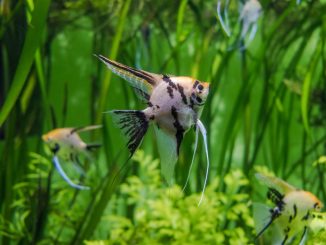
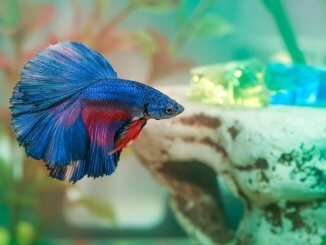
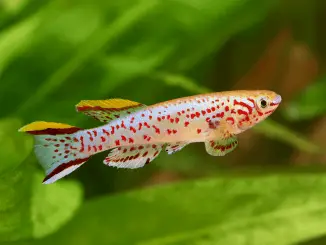
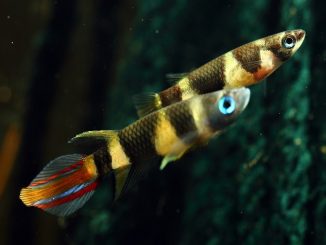
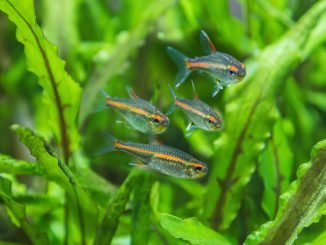


Be the first to comment